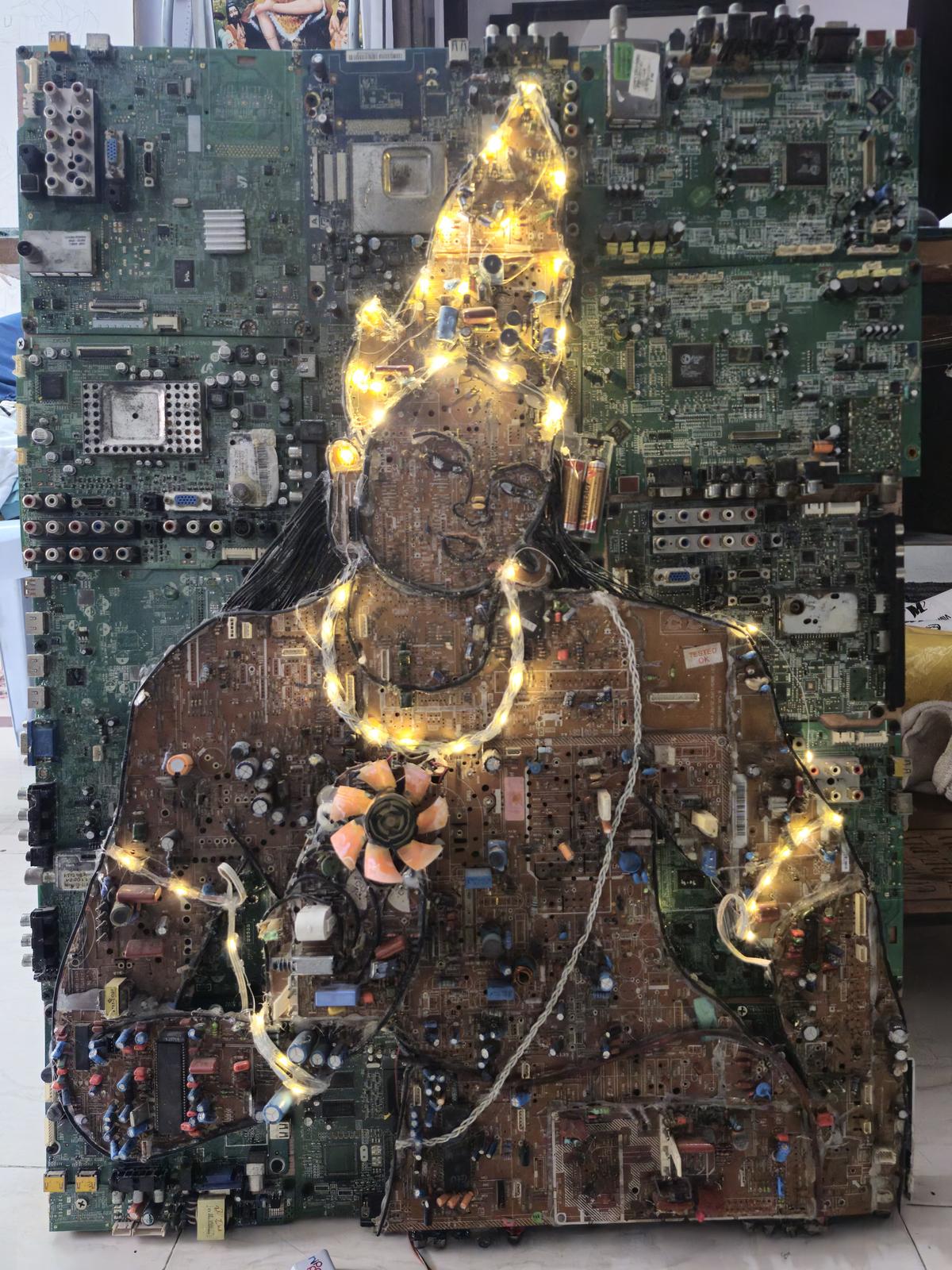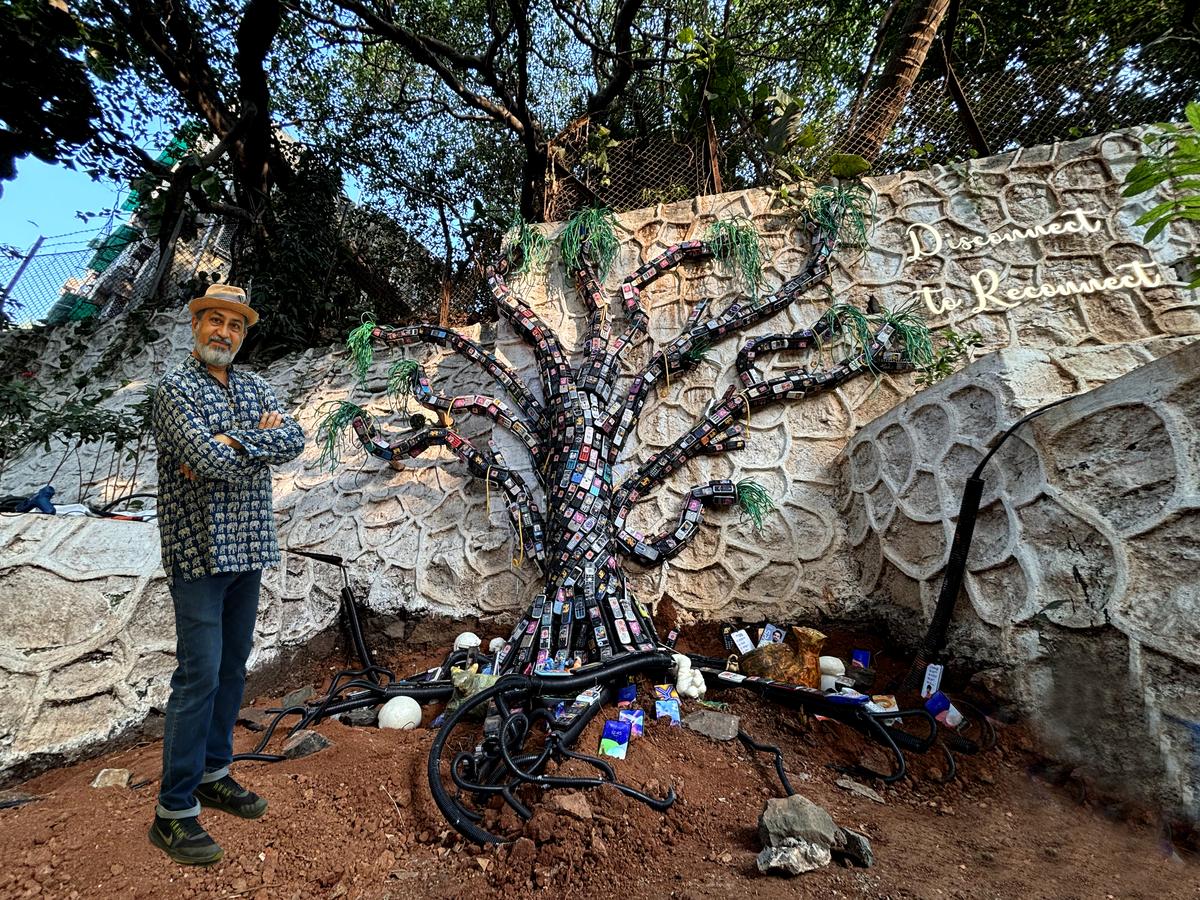
A ‘deer’ created out of discarded electronic waste at Sattva Signature Towers in Banjara Hills. The work has been created by sculptor Ranganadh Komari
| Photo Credit: Siddhant Thakur/ Shot On OnePlus/ #FramesOfIndia
A 14×22-foot green ‘tree’ — lush with white, pink, and yellow flowers — rises up one of the walls at Sattva Knowledge Park in Hyderabad’s Hitech City. At first glance, it looks like a vibrant mural. But look closer: this 600 kilogram Tree of Tech is made entirely from discarded electronics — motherboards, circuit boards, keyboard wires, switches, mouse cables, and metal plates from old desktops. Its symmetry and depth come alive through painted MDF cut-outs of leaves, flowers, and branches, giving the piece a striking, sculptural effect.

Ranganadh Komari
| Photo Credit:
Special Arrangement
“Recycling e-waste into art is a small step towards sustainability,” says artist and sculptor Ranganadh Komari, who created the work alongside fellow artists Ram Bhoopal and Applachary for the Sattva Group. The trio also crafted a life-sized deer from e-waste at the group’s Sattva Signature Towers in Banjara Hills. “At JNAFAU, our professors constantly encouraged us to explore scrap as a medium,” Ranganadh recalls, referring to his interest in recycling that dates back to 2010.

Tree of Tech, made from discarded electronics
| Photo Credit:
Special Arrangement
Ahead of World Environment Day on June 5, such works are drawing attention to the role artists play in repurposing e-waste. For Chetan Sai Vignesh, an art student, working with scrap was a creative turning point. His recent 3×2-foot mural of Padmapani — drawn from the Ajanta caves — uses motherboards, wires, and vintage television parts. “I first sketched the figure onto plywood, then layered and cut the electronic parts to fit the form,” he explains.

Padmapani, a mural created out of motherboards, wires, and vintage television parts
| Photo Credit:
Special Arrangement
But turning tech trash into visual storytelling comes with challenges — from sourcing components to making them aesthetically compelling. “The concept was ‘growth’,” says Ranganadh of the tree mural. “We sourced components from Secunderabad and Mumbai, and used Photoshop to prototype the design. But just the e-waste felt too flat. So we introduced carved MDF for a 3D effect.” The structure, made heavier by its 25mm plywood base, was eventually divided into four parts for transport. “Cutting motherboards is tricky, they chip easily, and some shards are sharp enough to injure.”

Leading sustainability

‘Disconnect to Reconnect’ e waste installation by Vishwanath Mallabadi Davangere
| Photo Credit:
Special Arrangement
While artists across India are experimenting with e-waste, one of its earliest adopters is Bengaluru-based Vishwanath Mallabadi Davangere. For over 30 years, the 64-year-old has been crafting birds, animals, and abstract figures from resistors, capacitors, coiled diodes, and keyboard keys. “I was always fascinated by what lay inside a gadget,” he says. As his studio filled up, he began selling pieces to make space. A sustainability conference in Hyderabad in 2019 was a turning point. “It gave me the platform to showcase this niche form of art,” he recalls. He now conducts online workshops, introducing others to the medium.
Still, Vishwanath is pragmatic. “Creative expression is vital, but art alone cannot resolve the e-waste crisis,” he says. “Recyclers face numerous challenges — extracting gold from circuit boards is chemically complex and economically unviable at scale.”
Close-up of the ‘deer’ created out of discarded electronic waste at Sattva Signature Towers in Banjara Hills. The work has been created by sculptor Ranganadh Komari
| Photo Credit:
Siddhant Thakur/ Shot On OnePlus/ #FramesOfIndia
The United Nations’ Global E-Waste Monitor 2024 paints a sobering picture. Electronic waste is growing five times faster than it’s being formally recycled. As reported in The Hindu, India’s e-waste volumes have surged by over 150% in six years — from 7,08,445 metric tonnes in 2017–18 to 17,78,400 metric tonnes in 2023–24. That’s an annual increase of nearly 1.7 lakh tonnes.
Given the magnitude of the crisis, e-waste art may only scratch the surface. But it serves an equally vital purpose — raising awareness, prompting dialogue, and inspiring creative solutions. Because sometimes, the best way to confront a looming environmental challenge is to make people stop and look.
Published – June 04, 2025 02:19 pm IST


